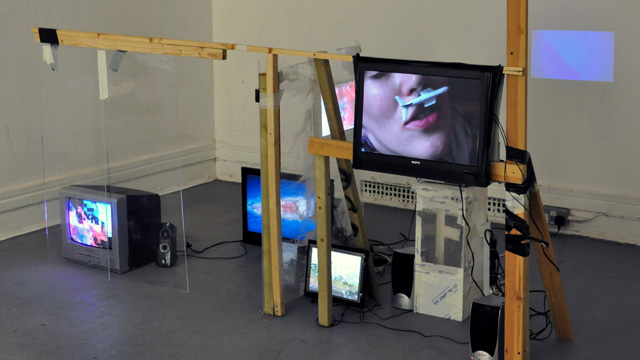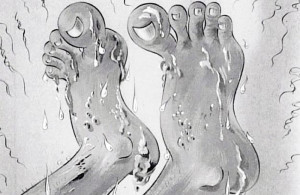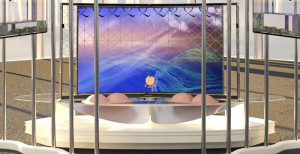“That’s probably called ‘Untitled’,” Jesse Darling says, through a chuckle, about the raw wood and glass construction lent at an angle atop a single, upright plank. It’s standing, precarious, next to ‘Ground Zero Suite’, a rough and unfinished installation on display in the concrete space of the Slade MA/MFA Interim show. Here, several screens and projections play at once. There’s a pixelated video of a flock of pigeons taking flight, a collapsing World Trade Centre disintegrating further into glitch and compression; flowers, tetris, a swastika and the confronting image of goatse –a rickroll meme of an anus stretched to the width of a fist –being assaulted by an ice-pick as the dazzling reverberations come in the form of colours from a Mac OS X Lion wallpaper. About a video at the foreground of the tumbledown structure -a sequence of edited footage featuring Darling and accomplices deep throat-ing toy airplanes in a house share in Camberwell -she offers, “people were prepared to put it in their arse or vagina, but then I was like, ‘I think we got the shot, guys.”
It’s this violent, often confronting, approach to performativity that distinguishes Darling’s work as such a thought provoking creative prospect. Her practice seems to function on meeting cruelty with cruelty; a resistance to “phallic modernity” –as central to patriarchal oppression –through rupture, aggressively engaging her audience with the realms of the “unthinkable”.

It’s not that much of a stretch then, that conversation with Darling extends well beyond the Slade exhibition (and the twenty minutes I’ve actually recorded) to the pub and then the Superenhanced interrogation room at UBERMORGEN’s u s e r f r i e n d l y exhibition at Carroll / Fletcher (my idea). Freely entering into a situation where she ends up hooded and handcuffed to the floor, while answering all sorts of intrusive personal questions read out from a tablet computer, it later becomes apparent that this devolution into slightly BDSM role play is not only an extension of Darling’s ideas of contingency (later in an email she points out, “of course you were the interrogator; this was, after all, an interview”) but her queer utopian ideals of transparency. Because, in entering into what she calls “a finite temporal state of circumstances agreed on by consenting adults who assume equal agency”, Darling is applying to an ideological state where social representation is the result of a personal decision, rather than a public demand.
As she tells me on several occasions, Darling doesn’t usually, or ever, agree to face-to-face interviews and it occurs to me that what’s more interesting than the revelation itself, is that the line between her private and public self is an exceedingly hazy one. She often uses her own body in her work, offers self-exposing commentary via social networks and is rather open about her past and present circumstances generally. But there’s also a limit to how far I can go in divulging that information myself. After all, it’s a matter of that very ‘agency’ Darling mentions earlier; a control over a self-representation that is unmediated by a third party. Because, as she says, “people read all kinds of the wrong shit”.
Do you want to talk me through this installation?
Jesse Darling: I built that up. If it was shown somewhere else, I’d have to go and build it somewhere else. You can’t put this in a packing case and send it off; you always have to remake it. It’s my labour that’s in it and there’s this aspect of performance.
Obviously the white box of the gallery sort of legitimises this stuff because it throws it into relief, compared to most of the conventions of showing work. But, on the other hand, when you walk out of the gallery the whole world’s falling down. I don’t want there to be so much separation between that space and the spaces I’m creating.
Why the repetition of the goatse?
JD: It’s just repeated as the image of the unthinkable. The hole. Ground zero. It starts from this thinking that when 9/11 happened, it was talked about in the rhetoric of rape, a lot. Like, ‘America had been fucked’.
Basically, this idea of the worst thing that could happen is that a body is penetrated. That’s the worst thing that could happen to this imperial body. But, in queer or feminist terms, it’s like, ‘ok, that’s the worst thing that could happen, is it? And then that devalues the body, does it?’
I found this really interesting rhetoric, that was obviously unthinking. It’s completely patriarchal imperial thinking but it goes deep. I’m not really thinking on the level of politics. I’m just talking about it. It’s quite intuitive but I feel like, beneath all this political stuff and the ‘war on terror’, there’s all this kind of really deep, weird libidinal, Freudian terror, of different kinds of rupture.
It reminds me of how sexual the experience of fighting in a war is supposed to be. That the weaponry itself is built in such a way that it can stimulate orgasms.
JD: Yeah. I think Hito Steyerl talks about that sort of thing. Not explicitly, but talking about the longing, the libido, of war and how it’s completely in every aspect of ourselves. But rather than using military images and stuff, because I don’t know anything about that, I’ve never been in Syria and I’ve never been in the army, I kind of want to make this point that the war, and this kind of conflict, and this rupture, and this sublime, it’s this total complicity with this violence. It’s happening inside us. In a house in Camberwell, and on your computer, and on YouTube and in our technologies. The glitch is a bit of a symbol of this rupture. There’s a lot of thinking in it somehow. I also don’t want it to cohere in a lot of ways. You’ve read my piece [‘Precarious Architectures and the Slippage of the Phallic Modern’]. It’s that sort of thing.
JD: It kind of is but what I’m trying to do always is propose this poetic reality in which all these things fit together but I know that whenever I have to explain it I can’t and that’s why I’m making work about it. Or I can but I’m saying a lot of things. The reason it’s not quite finished is it has to be monolithic but anti-monolithic. Ideally, I’d hang it from the ceiling. This is like a version of ‘Ground Zero Suite’ but I want to show it again, basically.
To me cohesion implies dogma. The tipping point between a symbol that can either signify peace or violence is so insignificant, in the same way that there’s such a fine balance between a system that works and a system that’s fucked. It’s still a system.
JD: Totally. Exactly like that. Maybe I want to have several dogmas running concurrently so that it doesn’t quite cohere and that’s why it looks like this. That’s why it looks like, if you pushed it, it would all fall down. That’s the idea. That’s why I want to hang it, rather than stand it. I feel like the conventions of art-viewing mean that people don’t walk inside because they don’t want to be the one to knock it down. I think that they shouldn’t feel like they’re the one to knock it down. They should feel like this could all fall down on them at any second.
So you should encourage people to walk underneath it.
JD: Well, probably not because it could fuck ‘em up.
I wonder how that translates, in terms of superstition about walking under ladders. Maybe it’s a really rational fear: ‘it could fall on me’.
JD: But there’s the fact that people don’t. Like I say, it’s complicated but I want this sense of the precariousness, like, ‘what is that, are you joking?’ If people look at it this and are just like, ‘this is so fucking amateur’. Good. I say I’m a bad engineer but I know how to do things. I just don’t want to because I’ve got a point to make.
This framing is also sort of like that dogma. You put something in a frame. You put it all nice and put it somewhere in a gallery and you’re like, ‘that’s it, that’s the truth’. Fuck that man. There’s so many problems, historically, with, ‘whose truth is it and what for?’
So is it a conscious decision to disrupt these systems, these dogmas?
JD: I’m a bit resistant to this idea of taking a position. Slipping in to the position, which is given un-problematically: ‘voila, there you go, here’s a place for your truth to sit. We’ll chuck it there in the ‘Hall of Truths’ and archive it among the ‘greatest’ and ‘goods’. I’ve also said, this idea of the author, that’s a totally humanist fucking colonial, patriarchal concept.
I’m not really a politico, that’s not my angle. I just don’t want to die and I don’t want to be mummified like that -I don’t want my work to be, and I don’t want to be. I want the long game of my, or our, narratives.
I went to see the Guerrilla Girls talk recently. They were saying they’ve been active since the 80s and they’ve got more exposure, yet nothing much has changed in terms of the structures they’re resisting.
JD: No but maybe it’s, like I say, a really long game. Thirty years is not that long. I’m not trying to change anything on the level of structures. All I’ve got is my own conceptual agenda and that’s it. At least I can do that. At least I can refuse some of the conventions and make this ugly fucking semi-offensive work. **















